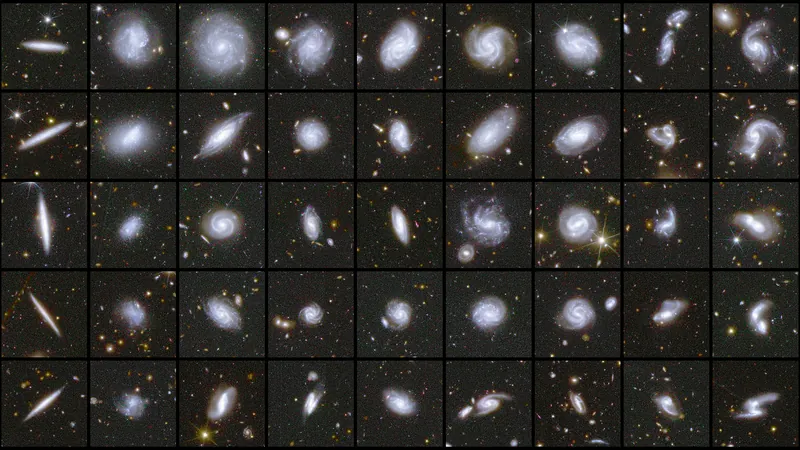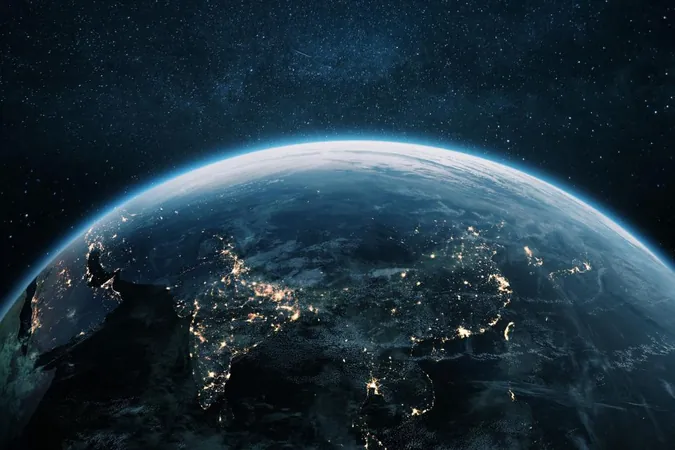
Groundbreaking Discovery: 26 Million Galaxies Captured in Stunning Photos as ESA's Euclid Mission Unveils Cosmic Marvel
2025-03-26
Author: Lok
Introduction
The European Space Agency (ESA) has announced a monumental achievement with the first data release from its Euclid mission, revealing breathtaking images of a highly diverse collection of galaxies, clusters, and expansive cosmic fields. This massive data release represents an early glimpse into what is set to become one of the largest maps of the cosmos ever created.
The Mission's Achievements
In an impressive feat, the Euclid mission mapped an astonishing 63 square degrees of the galaxy-filled sky in a mere week—an area equivalent to 300 full Moons on the night sky. Within this vast space, over 26 million galaxies were detected, including quasars that are located up to a staggering 10.5 billion light-years away. The Euclid project aims to scan three designated areas of the sky between 30 and 52 times before its mission concludes in 2030, promising to yield an extraordinarily detailed 3D cosmic atlas that will enhance our understanding of galaxy formation and the enigmatic role of dark matter.
Expert Insights
Professor Carole Mundell, director of science at ESA, expressed excitement about the immense data potential, stating, “We are unlocking a treasure trove of information for scientists to dive into.” This new data will not only improve our knowledge of galaxies but will shed light on the fundamental components that make up our universe.
Advanced Technology and Collaboration
Utilizing its advanced visible and near-infrared instruments, Euclid captures a clearer picture of the universe’s large-scale structure. The mission is crucial for identifying the pervasive filaments of both normal and dark matter that stretch across the cosmos—structures upon which galaxies have birthed and evolved. “Just think of the discoveries that await us,” commented Valeria Pettorino, an astrophysicist involved with the project.
Data Management Innovations
As Euclid generates vast amounts of data—around 100 GB daily—scientists are employing innovative approaches, including artificial intelligence and contributions from citizen scientists. One groundbreaking outcome of this collaboration is a new catalogue of over 380,000 galaxies, systematically classified by their shapes and features. Mike Walmsley, a member of the Euclid Consortium, emphasized the integral role that AI plays in managing the extensive datasets produced by the mission, revealing that the Zoobot algorithm has been trained by nearly 10,000 volunteers to identify unique astronomical traits.
Gravitational Lensing and Dark Matter
Moreover, Euclid's observations are also revealing phenomena such as gravitational lensing. This occurs when light from distant galaxies is bent by the gravitational influence of matter, allowing scientists to infer the presence of dark matter. To date, Euclid has identified 500 potential instances of strong gravitational lenses—most of which had never been documented before. The mission aims to uncover around 100,000 of these lensing effects, offering invaluable insights into the distribution of dark matter across the universe.
Future Expectations
Looking ahead, by March 2025, Euclid expects to have surveyed 2,000 square degrees of sky—approximately 14% of its ultimate target. The mission is set to release its first comprehensive cosmology data in October 2026, which will include multiple observations of select ‘deep fields.’ These scans are expected to provide deeper insights into the universe’s hidden structures.
Collaboration and Public Engagement
Launched in July 2023 and beginning regular observations in February 2024, the Euclid mission showcases ESA’s collaboration with NASA and aerospace giants like Thales Alenia Space and Airbus, along with a global consortium of over 2,000 scientists from 15 different countries.
Public Access to Data
The first deep field images are now available for public exploration via the ESASky platform, marking just the beginning of a new era in cosmic exploration. With Euclid, we are on the brink of uncovering the intricacies and mysteries of our universe like never before. Prepare for a journey that will redefine our understanding of cosmic genesis and evolution!


 Brasil (PT)
Brasil (PT)
 Canada (EN)
Canada (EN)
 Chile (ES)
Chile (ES)
 Česko (CS)
Česko (CS)
 대한민국 (KO)
대한민국 (KO)
 España (ES)
España (ES)
 France (FR)
France (FR)
 Hong Kong (EN)
Hong Kong (EN)
 Italia (IT)
Italia (IT)
 日本 (JA)
日本 (JA)
 Magyarország (HU)
Magyarország (HU)
 Norge (NO)
Norge (NO)
 Polska (PL)
Polska (PL)
 Schweiz (DE)
Schweiz (DE)
 Singapore (EN)
Singapore (EN)
 Sverige (SV)
Sverige (SV)
 Suomi (FI)
Suomi (FI)
 Türkiye (TR)
Türkiye (TR)
 الإمارات العربية المتحدة (AR)
الإمارات العربية المتحدة (AR)